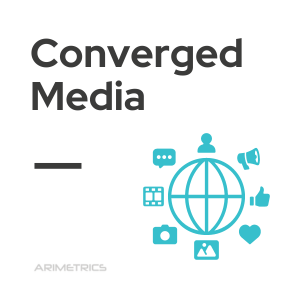 Definition
Definition
Converged media is a marketing strategy that combines multiple communication channels to create a more complete consumer experience. Instead of relying on a single channel, such as TV or social media, converged media uses a combination of online and offline channels to reach the target audience more effectively.
The ultimate goal of converged media is to create a seamless, integrated customer experience in which brand messages are delivered consistently across all media and platforms. Converged media also allows brands to tailor their content and messaging to different platforms more effectively, thereby optimizing the marketing budget.
Types of converged media
We can classify the convergence media as follows:
- Social Media: It is an essential part of converged media, as it allows brands to interact with their audience in a more personal and direct way. Through content publishing and two-way communication, brands can create a stronger, longer-lasting relationship with their customers.
- Programmatic advertising: Programmatic advertising refers to the use of technology to buy and sell ads in real time. This technique is used to reach consumers online, providing greater reach and better targeting in the audience.
- Out-of-home (OOH) Advertising: Out-of-home advertising, such as billboard ads, on buses, or in subway stations, is another type of converged media. By using OOH, brands can reach consumers on the go, increasing their exposure and brand awareness.
- Content marketing: It involves the creation and distribution of useful and relevant content, which helps brands attract and retain customers. By combining different types of content, such as blogs, videos, and podcasts, brands can create a more complete and engaging experience for their customers.
Benefits of converged media
Among the advantages of media convergence we can highlight:
- Improves customer experience: By utilizing multiple communication channels, converged media enables brands to create an integrated and consistent customer experience in which messages are consistently delivered across all media and platforms. This improves the customer experience and increases the chances of loyalty.
- Increase marketing effectiveness: By using a combination of online and offline channels, converged media allows brands to reach their target audience more effectively. It also allows them to tailor messages and content to different platforms, increasing marketing effectiveness.
- Improves audience targeting: Programmatic advertising, one of the types of converged media, allows brands to reach consumers more effectively and targeted. By using tracking data and targeting algorithms, brands can show relevant ads to consumers in real time.
- Increase brand exposure: Out-of-home advertising, such as ads on billboards, buses, and subway stations, allows brands to increase their exposure and brand awareness. By reaching consumers on the go, brands can increase their brand visibility and improve their market positioning.
- Encourage interaction and relationship with customers: Social networks, an essential part of converged media, allow brands to interact with their audience in a more personal and direct way. Through publishing relevant content and two-way communication, brands can build a stronger, longer-lasting relationship with their customers. This can lead to increased customer engagement and loyalty towards the brand.
Examples of converged media
Below are some brands that have excelled in the use of converged media to maximize their impact and reach in the market.
- Coca-Cola: The brand uses a combination of social media advertising, TV commercials, and OOH campaigns, such as posters at sporting events, to ensure that its message reaches a global audience in a consistent manner.
- Nike: Integrates content marketing through inspirational videos on platforms such as YouTube, along with programmatic advertising to personalize online ads based on user behavior.
- Starbucks: Uses its mobile app to offer personalized promotions, combining this with social media campaigns and in-store advertising to create a cohesive customer experience.
- IKEA: Combines print catalogs, online advertising, and augmented reality applications to allow customers to visualize how furniture would look in their homes, enhancing the shopping experience.
- Red Bull: Uses a converged media strategy that includes live events, online video content, and social media presence to promote its brand as a lifestyle, beyond just a product.
- Amazon: Integrates online advertising, personalized recommendations based on user data, and video content into its streaming platform to offer an integrated and personalized user experience.
